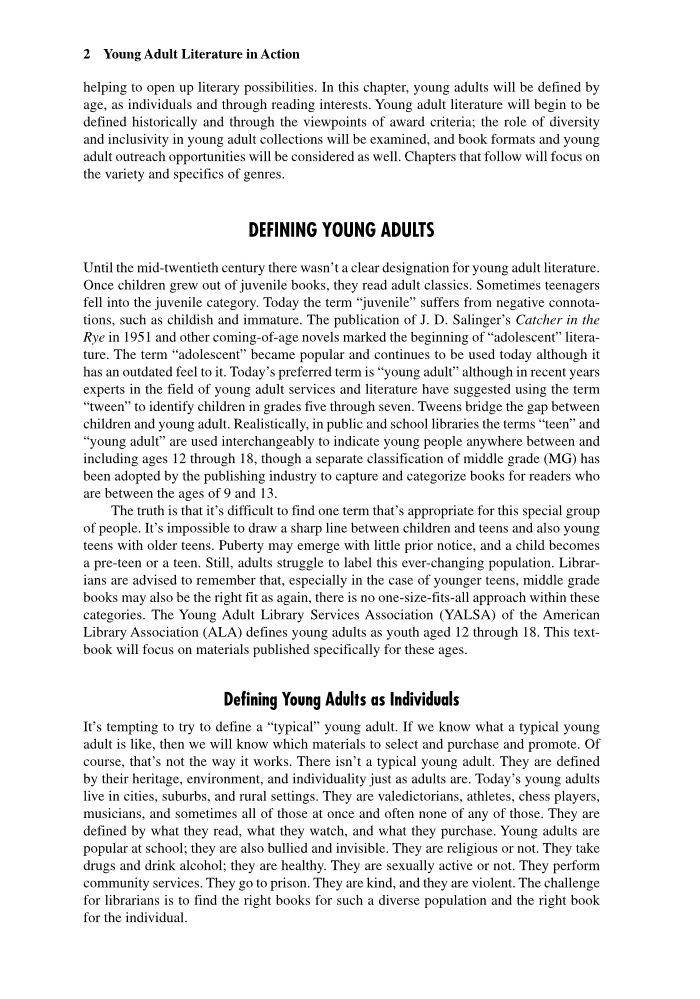2 Young Adult Literature in Action helping to open up literary possibilities. In this chapter, young adults will be defined by age, as individuals and through reading interests. Young adult literature will begin to be defined historically and through the viewpoints of award criteria the role of diversity and inclusivity in young adult collections will be examined, and book formats and young adult outreach opportunities will be considered as well. Chapters that follow will focus on the variety and specifics of genres. DEFINING YOUNG ADULTS Until the mid-twentieth century there wasnÊt a clear designation for young adult literature. Once children grew out of juvenile books, they read adult classics. Sometimes teenagers fell into the juvenile category. Today the term „juvenile‰ suffers from negative connota- tions, such as childish and immature. The publication of J. D. SalingerÊs Catcher in the Rye in 1951 and other coming-of-age novels marked the beginning of „adolescent‰ litera- ture. The term „adolescent‰ became popular and continues to be used today although it has an outdated feel to it. TodayÊs preferred term is „young adult‰ although in recent years experts in the field of young adult services and literature have suggested using the term „tween‰ to identify children in grades five through seven. Tweens bridge the gap between children and young adult. Realistically, in public and school libraries the terms „teen‰ and „young adult‰ are used interchangeably to indicate young people anywhere between and including ages 12 through 18, though a separate classification of middle grade (MG) has been adopted by the publishing industry to capture and categorize books for readers who are between the ages of 9 and 13. The truth is that itÊs difficult to find one term thatÊs appropriate for this special group of people. ItÊs impossible to draw a sharp line between children and teens and also young teens with older teens. Puberty may emerge with little prior notice, and a child becomes a pre-teen or a teen. Still, adults struggle to label this ever-changing population. Librar- ians are advised to remember that, especially in the case of younger teens, middle grade books may also be the right fit as again, there is no one-size-fits-all approach within these categories. The Young Adult Library Services Association (YALSA) of the American Library Association (ALA) defines young adults as youth aged 12 through 18. This text- book will focus on materials published specifically for these ages. Defi ning Young Adults as Individuals ItÊs tempting to try to define a „typical‰ young adult. If we know what a typical young adult is like, then we will know which materials to select and purchase and promote. Of course, thatÊs not the way it works. There isnÊt a typical young adult. They are defined by their heritage, environment, and individuality just as adults are. TodayÊs young adults live in cities, suburbs, and rural settings. They are valedictorians, athletes, chess players, musicians, and sometimes all of those at once and often none of any of those. They are defined by what they read, what they watch, and what they purchase. Young adults are popular at school they are also bullied and invisible. They are religious or not. They take drugs and drink alcohol they are healthy. They are sexually active or not. They perform community services. They go to prison. They are kind, and they are violent. The challenge for librarians is to find the right books for such a diverse population and the right book for the individual.
Document Details My Account Print multiple pages
Print
You have printed 0 times in the last 24 hours.
Your print count will reset on at .
You may print 0 more time(s) before then.
You may print a maximum of 0 pages at a time.
















































































































































































































































